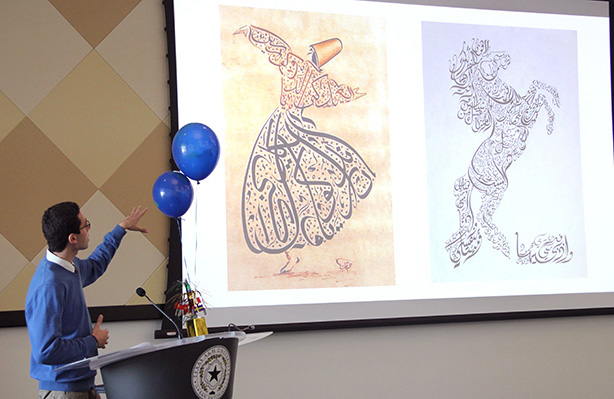
By Justin Rodriguez
Savory smells welcomed students and guests into the Vista Room in the Central Academic Building to a culmination of taste, delicacy and tradition, in celebration of International Education Week.
“Lets listen to the aroma of the cuisines,” said Sylvia Medel, director of International Affairs.
Worldwide celebrations for International Education Week take place in a variety of settings, but at Texas A&M University-San Antonio, students sampled regional Middle Eastern food and participated in international presentations, sponsored by the office of international affairs at multiple events from Nov. 17-21.
The U.S. State Department and Department of Education coordinated International Education Week, a global week-long event, to commemorate benefits of international education and exchange worldwide.
Texas A&M University-San Antonio students delved into Middle Eastern cultures and nationalities including Syria, Palestine and Iraq.
For international students Ahmad Tabbakh, Banan Ali, and Yousef Zayed, it proved to be an opportunity to illuminate the positive and lesser known attributes of the countries they call home. Each student illustrated thriving traditions in their countries.
“We see the radical side, but we don’t always get to see the people,” said English senior Hannah Mueller when describing the Middle East in the news. Mueller participated in the event to learn about Middle Eastern culture.
International Connections
Syria:
Tabbakh, a native of Aleppo City in Syria, strived to articulate the artistic and historical aspects of Syrian life. However, he also hinted at several political conflicts, as well as destruction in Syria, at the “Celebrating My Homeland, the Middle East” event.
Tabbakh, an architecture sophomore at San Antonio College, noted the education system in Syria as developing, whereas in the U.S. students can learn how to set goals and work towards them.
“Education is easily accessible,” Tabbakh said, regarding education in the U.S.
He initially came to Chicago, where he learned about public transportation and how the city’s architecture displayed a range of diverse cultures, as opposed to Syria’s uniform culture.
“The architecture can tell you who lives in this country,” Tabbakh said, using the centuries-old Aleppo Citadel as an example. “The urban design of the city (Aleppo) connects people with no respect for diversity.”
A defining characteristic of Syria and Muslim culture are the “souks,” which are open-air marketplaces known for offering countless goods and services, such as woven clothes, pottery, food, arabic tea and Turkish coffee.
“It’s a very rich culture enriched by culture and residents that inhabit it,” Tabbakh added while describing Syria as a birthplace of the semitic languages.
The semitic languages remained throughout religious literature and are considered similar to each other like those of the Romance or Germanic languages.
Iraq:
Ali, who is from Baghdad and is a specialist within the office of international affairs, briefly described the land during her presentation in relation to the two major rivers, the Tigris and Euphrates, which run through Iraq. The land in between each of these rivers is abundantly fertile, meaning it is capable of producing large quantities of vegetation.
Ali noted the two rivers as the only rivers to flow through Iraq and the acclaimed “fertile crescent.”
According to an article in the Economist, the areas surrounding Iraq were depleted of 144 cubic kilometers of fresh water between 2003 and 2009.
Ali described the Iraqi culture, such as palm trees at every family home, as well as the tomb of the unknown soldier in Baghdad. Farmers have cultivated these trees, and the date, a fruit with a raisin-like texture, for centuries and prove to be a staple of revenue.
In Iraq, it’s customary for each family to have palm trees in their yard or surrounding land.
As a result of tension in the Middle East, some families have been forced to abandon their beloved trees. Date palms, in traditional Iraqi culture, are cherished for their resilience and surplus of uses like rope and woven baskets aside from their fruit.
Palestine:
Zayed, biology sophomore at San Antonio College, zeroed in on the foods and traditions of Palestine. He highlighted several Arabic sweets, knafeh, kaetif, and osmalia, typically served at lunch or after dinner.
Osmalia contains pistachios and animal ghee, sandwiched between two sugary and pastry-esque pieces of bread. “Ghee” is a type of butter made from animal fat, which holds the pistachios in place.
In addition to the rich food, Zayed touched on several architectural and political aspects in relation to Israel, and its separation from Israel as a result of conflict in the 1940s.
Palestine was part of the Ottoman empire for 400 years until World War I, at which time Palestine fell under British control.
The country, composed of two land masses — the Gaza strip and the West Bank — now sit landlocked inside of Israel. Zayed added that Palestine has continually decreased in size as as result of Israeli occupation.
Many Palestinians became frustrated and continue to protest the occupation of Israelis.
“Palestinians want to visit the Dome of the Rock (a Palestinian mosque) but they can’t because Israeli’s won’t let them,” said Zayed, adding that visitors to the mosque are typically over the age of 50. Younger individuals, who typically wish to protest, have historically been turned away by the “Imam,” the religious leader of the mosque.
“People should be treated equally, be able to live free and not under occupation and control where so many rules apply,” said Zayed.
Cultural Perspective
The university also held movie screenings, which included several staples of Chinese and Indian culture like samosas (potato stuffed pastries) and chai tea.
Students of A&M-San Antonio benefit from international education interaction in terms of global diversity and awareness, student conduct officer Maximo Anguino said.
Students were engulfed in the Indian movie “Slumdog Millionaire,” which targets human trafficking and child exploitation, while snacking and drinking chai tea.
“It’s good to come together and learn from each other,” Anguino added. “Film is very powerful. These movies and this week highlight the humanity aspect.”
Anguino expressed interest in future interaction with individuals who have experienced or come into contact with someone who has encountered such scenarios in subsequent International Education Week events.
Anguino conveyed the importance of interaction with not just international students but also cultures outside of the U.S. by incorporating various customs and traditions into our own.
“The United States has its downfalls, but some countries have it a lot worse,” said Anguino.
“If people take the time to get to know each other they will realize we are a lot similar than we are different.”
“Knowing about another culture helps you understand how to incorporate other cultures into the classrooms,” said Mueller.






